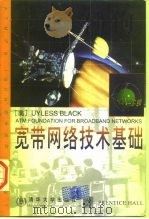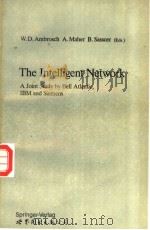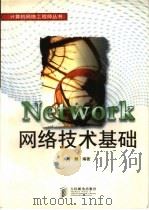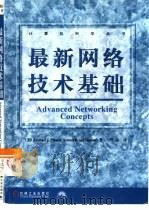《宽带网络技术基础 英文版》
| 作者 | (美)(U.布莱克)Uyless Black著 编者 |
|---|---|
| 出版 | 北京:清华大学出版社 |
| 参考页数 | 426 |
| 出版时间 | 1998(求助前请核对) 目录预览 |
| ISBN号 | 7302028168 — 求助条款 |
| PDF编号 | 87534518(仅供预览,未存储实际文件) |
| 求助格式 | 扫描PDF(若分多册发行,每次仅能受理1册) |

CHAPTER 1Introduction1
Introduction1
The Present Telecommunications Infrastructure1
Present Technologies for Voice,Video,and DataNetworks2
Present and Future Requirements5
Downsizing and Outsourcing6
Present Systems6
Costs of Leased Lines8
Virtual Companies and Virtual Networks9
Fast Relay Networks and ATM12
Development of ATM14
Applications use of ATM14
Fast Relay Networks and SONET16
Broadband ISDN19
Summary21
CHAPTER 2The Nature of Analog and Digital Systems22
Introduction22
Analog Systems22
Cycles,Frequency,and Period23
Bandwidth24
Broadband and Baseband Signals26
Other Definitions of Broadband27
Channel(Link)Capacity27
Noiseless Channels and Harry Nyquest28
Noisy Channels29
The Signal-to-Noise Ratio30
The Analog-to-Digital Conversion Process30
Sampling,Quantizing,and Encoding31
Other Coding Schemes34
Plesiochronous Networks35
Timing and Synchronization in Digital Networks35
The Synchronous Clock Hierarchv36
Clarification ofTerms37
Timing Variations37
Slips—Controlled and Uncontrolled38
Bit or Clock Slips39
Summary39
CHAPTER 3Layered Protocols,the Architecturefor ATM and SONET Networks40
Introduction40
Protocols and the OSI Model40
OSI Layer Operations42
Concept of a Service Provider43
ATM andtheModel48
Protocol Entities48
Service Access Points(SAPs)49
ATM and OSI Layers49
The Internet Protocols(TCP/IP)51
The Internet Layers52
IP Functions54
TCP Operations56
Summary58
The OSI Network and Transport Layer58
CHAPTER 4Emerged Technologies59
Introduction59
Comparison of Switching Systems59
The T1/E1 Systems61
Purpose ofT1 and E161
Typical Topology62
T1 and E1 Layers63
T1/E1 PDUs63
X.2565
Purpose of X.2565
Conclusions on T1/E165
Typical Topology66
X.25 Layers67
X.25PDUs68
Other Noteworthy Aspects of X.2569
Conclusions on X.2570
Integrated Services Digital Network(ISDN)71
Purpose of ISDN71
Typical Topology71
ISDNPDUs74
ISDN Layers74
Conclusions on ISDN79
Signaling System Number 7(SS7)80
Purpose of SS780
Typical Topology80
SS7 Layers81
SS7PDUs84
Conclusions on SS785
ATM and SONET:Reduction or Enhancementof Functions in Networks86
Summary86
Introduction87
ISDN and B-ISDN87
CHAPTER 5The Broadband Integrated ServicesDigital Network(B-ISDN)Model87
B-ISDN Configurations88
ATM and the B-ISDN Model89
Examples of the Operations between Layersin the B-ISDN Planes91
B-ISDN Functions93
B-ISDN Service Aspects95
Summary97
CHAPTER 6Asynchronous Transfer Mode(ArM)Basics98
Introduction98
The Purpose of ATM98
An ATM Topology99
Pertinent Standards99
The VPI and VCI Labels103
ATMLayers105
ATM Layers and OSI Layers106
Relationship of AAL,ATM,and theNetwork108
Relationship of Layers to the OSI LayeredArchitecture110
Where to Find Service Definitionsand Primitives111
Typical Protocol Stacks111
ATM PDUs(CELLs)113
Use of Two Identifiers114
Metasignaling Cells and OtherCells115
RationalefortheCell Size116
Network Transparency Operations119
Errors and Error Rates119
Error Correction and Detection122
Probability of Discarding Cells124
Overhead of the Cell Approach125
Transmission Delay126
ATMLabels128
MultiplexingⅥCs and VPIs130
Cell Relay Bearer Service(CRBS)130
Point-to-Multipoint and Multipoint-to-Multiooint Services132
ATM Interfaces133
Principal Specifications for ATM134
Summary135
CHAPTER 7The ATM Adaptation Layer(AAL)137
Introduction137
Principal Tasks of the AAL137
The AAL Sublayers139
Creating and Processing the AALPDU139
Classes ofTraffic141
Dividing CS into Further Sublayers143
Rationale for AAL Types143
AAL Naming Conventions144
AALType 1(AAL 1)144
The AAL 1 PDU145
AAL 1 Modes of Operation147
Synchronization and Clock Recovery148
RunningAAL 1 Trafficon a T1 Link148
AALType 2(AAL 2)149
TheAAL 2PDU150
Voice Packetization152
Grouping Samples into Blocks153
The Voice Packet156
Packet Buildout at the Receiver158
AALTypes 3,4,3/4,and 5(AAL 3,AAL4,AAL 3/4,andAAL 5)forData161
Pre-ATM Approach to Traffic IntegrityManagement161
ATM Approach to Traffice IntegrityManagement164
The Original AAL Type 3 and Type 4(AAL 3,AAL4)166
AAL3/4167
Naming Conventions for AAL 3/4167
TheAAL3/4PDU167
AAL 3/4 Headers and Trailers167
AAL 3/4 Sequencing and IdentificationOperations170
A Complete SAR-PDU and CPCS-PDUExample171
Functional Model for AAL 3/4173
AALType 5(AAL 5)175
Structure of AAL 5176
TheAAL 5PDU176
A New Type—Available Bit Rate(ABR)177
The A AL/ATM Primitives177
Summary180
Introduction181
ATM Switching181
CHAPTER 8ATM Switching Operations181
Routing with the Cell Header182
Space and Time Switching185
Digital Cross Connects186
The Switching Fabric186
Multiplexing and Label Mapping189
Switching Technologies191
Shared Memory Switch192
Shared Bus Switch192
Crossbar Switch193
Multistage Switching194
Banyan and Delta Switching Networks195
Example of an ATM Switch200
Summary202
CHAPTER 9Traffic Management203
Introduction203
Traffic Management in an ATM Network203
The Natural Bit Rate204
Traffic Control and Congestion Control206
Functions to Achieve Traffic Control andCongestion Control206
Allocation of Bandwidth206
Computing the Parameters for QueueServicing210
Dealing with Variable Delay211
Connection Admission Control(CAC)Procedures212
Usage Parameter Control(UPC)214
Performance Parameters at the UNI215
ITU-T Recommendation I.35B215
Traffic Management at the UNI—BasicConcepts215
Eckberg Scheme215
Multiplexing Traffic into the Cells218
Token Pools and Leaky Buckets218
ATM Bearer Service Attributes at the UNI222
Allocating Resources222
Traffic Control and Congestion Control223
Cell Arrival Rate and Cell Interval224
ATM Cell Transfer Performance Parameters226
ATM Layer Provisions for Quality of Service(QOS)227
ATM Forum and ITU-T Traffic Control andCongestion Control228
Generic Cell Rate Algorithm(GCRA)229
The Peak Cell Rate Reference Model230
Cell Delay Variation(CDV)Tolerance233
Examples ofABR Operations235
ManagingLANTrafficwiththe AvailableBitRate(ABR)235
Types of Feedback238
Buildout Delay Proeedures at the ReceivingEndpoint240
Summary240
CHAPTER 10Call and Connection Control241
Introduction241
ATM Connections on Demand241
The ATM Address244
Address Registration247
The Connection Control Messages248
Connection Setups and Clears248
Q.2931 Timers and States250
Connection Control Examples251
Connection Setup252
Connection Release254
Restart Procedure255
Status Inquiry256
AddParty256
Drop Party259
Signaling AAL Reset and Failure259
Messages for Restart Operations260
Messages for Adding and DroppingParties260
Messages for Call Control260
Functions of Q.2931 Messages and InformationElements260
Descriptions of the InformationElements262
Examples of Q.2931 Messages269
Coding Conventions269
AAL Parameters270
User Traffic Descriptors274
Summary275
Introduction276
The ATM Network as the Backbone for OtherNetworks276
CHAPTER 11Internetworking with ATM Networks276
Using Q.2931 to Support Protocol Capability(Tunneling)277
Broadband Low-Layer InformationElement280
The Network-to-Network Interface283
The ATM B-ISDN Inter Carrier Interface(B-ICI)284
Physical Layer Requirements at the B-ICI287
Traffic Management at the B-ICI287
Reference Traffic Loads287
B-ICI Layer Management Operations288
PVC Cell Relay Service(CRS)289
Specific Internetworking Services289
PVC Circuit Emulation Service(CES)290
PVC Frame Relay Service(FRS)290
SMDS Service295
ATM Backbones for LAN8297
ATM LAN Emulation299
ArM Edge Routers301
ATM Virtual Routers301
RFC 1483 and RFC 1577302
The ATM Data Exchange Interface(DXI)303
DXI Modes303
DXI Support for Frame Relay308
Summary310
CHAPTER 12Synchronous Optical Network(SONET)311
Introduction311
Purpose of SONET311
Present Transport Systems and SONET313
Foundations for SONET313
Synchronous Networks315
Optical Fiber—The Bedrock for SONET316
Pertinent Standards317
Typical SONET Topology319
SONET Configuration321
SONET Layers323
Automatic Protection Switching(APS)324
Payloads and Envelopes326
Envelopes326
Mapping ATM Cells into the SONETEnvelope329
Payload Pointers330
Mapping and Multiplexing Operations331
The Control Headers and Fields334
SONET Equipment335
Summary342
Progress in SONET Penetration342
CHAPTER 13Signaling:Operations,Administration,and Maintenance(OAM)343
The Network Management Model343
Operation and Maintenance(OAM)Operations344
ATM Functions at the U-and M-Planes347
U-Plane Operations347
M-Plane Operations349
End-to-End and Segment Flows350
Maintenance and Alarm Surveillance353
Failure States353
The SONET OAM Functions353
Alarm Indication Signals(AIS),FERF,and Yellow Signals354
Examples of Remedial Actions upon Enteringa Failure State355
The OAM Headers356
Section Overhead357
Line Overhead358
STS Path Overhead(STS POH)358
ATM Use of the OAM Octets360
Using Payload Pointers for TroubleshootingTiming Problems361
OAM at the ATM Layer362
Fault Management362
Performance Management364
Activation/Deactivation367
The ATM Management Information Bases(MIBs)368
The Interim Local Management Interface(ILMI)369
The ILMI MIB Groups370
ATM MIB(RFC 1695)372
The ATM MIB Groups372
The ILMI MIB and the ATM MIB377
The Layer Management/ATM Primitives379
Types of Signaling379
Status of Common Channel SignalingStandards379
Summary380
Physical Layer Options for ATM381
CHAPTER 14Physical Layer Services for ATM381
Introduction381
The ATM/Physical Layer Primitives382
ATM Mapping into SONET STS-3c383
ATM Mapping into DS3385
Other Aspects of the DS3 Scheme387
ATM Mapping into the 100 Mbit/s Multimode FiberInterface387
Functions of the U-Plane Physical Layer387
Private UNI for 51.84 Mbit/s and Subrates390
Shielded Twisted Pair Interface390
Multimode Fiber Interface390
ATM Mapping into the 155.52 Mbit/s PrivateUNI390
Mapping DS1,DS3,and CEPT Payloads into SONETFrames392
The VT/VC Structure393
Floating and Locked VT Mode396
Interworking ATM and SONET397
Summary398
CHAPTER 15The ATM Market400
Introduction400
Forecasts on the Use of ATM400
ATM Over T1/E1402
Trials and Test Beds403
ATM Vendors405
DEC and IBM ATM Efforts409
ATM Progress in Europe410
United Kingdom410
Examples of other Countries ATM Efforts412
Some Final Thoughts412
References414
Abbreviations418
Index420
1998《宽带网络技术基础 英文版》由于是年代较久的资料都绝版了,几乎不可能购买到实物。如果大家为了学习确实需要,可向博主求助其电子版PDF文件(由(美)(U.布莱克)Uyless Black著 1998 北京:清华大学出版社 出版的版本) 。对合法合规的求助,我会当即受理并将下载地址发送给你。
高度相关资料
-

- 计算机网络
- 1999 北京:北京邮电大学出版社
-

- 智能网络 英文版
- 北京/西安:世界图书出版公司
-

- 宽带匹配网络
- 1986 西北电讯工程学院出版社
-

- 网络技术
- 1989 上海:上海交通大学出版社
-

- 宽带通信网络
- 1998 北京:人民邮电出版社
-

- 网络技术基础
- 1998 北京:人民邮电出版社
-

- 网络互联技术基础教程
- 1994 北京:学苑出版社
-

- 网络基础
- 1999 北京:中华工商联合出版社
-

- 最新网络技术基础
- 1999 北京:机械工业出版社
-

- 网络五周通
- 1995 陕西电子杂志社
-

- 网络基础教程 第2版
- 1999 北京:清华大学出版社
-

- 网络综合与宽带匹配
- 1981 北京:国防工业出版社
-

- 网络互联技术基础
- 1998 北京:人民邮电出版社
-

- 网络技术基础
- 1996 北京:电子工业出版社
提示:百度云已更名为百度网盘(百度盘),天翼云盘、微盘下载地址……暂未提供。➥ PDF文字可复制化或转WORD
